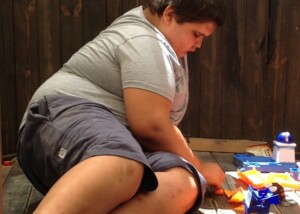In 1943, Austrian-American psychiatrist Dr. Leo Kanner published a groundbreaking paper titled “Autistic Disturbances of Affective Contact” in the journal Nervous Child.
This work is widely recognized as the first clinical description of autism as a unique condition, separate from schizophrenia or intellectual disability (Kanner, 1943).
Dr. Kanner analyzed 11 kids who exhibited a consistent set of characteristics including:
- Profound difficulties in social interaction
- A strong preference for routine
- Unusual use of language (e.g., echolalia or, for example, repeating what is spoken to them)
- Apparent indifference to others’ presence
He referred to this pattern as “early infantile autism.”
Autism as Innate, Not Acquired
Dr. Kanner explained that this condition was present from infancy.
This assertion challenged the prevailing belief at that time that autistic behaviors developed as a result of poor parenting or psychological trauma.
He noted that many of the kids came from intellectually advanced families and showed signs of intelligence, even brilliance, in narrow areas of interest — something not commonly associated with intellectual disability at the time.
For instance, such a child could have an amazing skill at playing the piano despite few, if any, lessons. Or, they might’ve been very adept in math or extremely knowledgeable of fossils.
This was a pivotal shift: Autism was beginning to be seen as a biologically based developmental difference, not an emotional disturbance or the result of corrupt parenting.
The “Refrigerator Mother” Theory
Ironically, despite his observations suggesting a biological cause, Dr. Kanner would later speculate that cold or emotionally distant parenting could play a role in autism’s development.
This notion evolved into the damaging “refrigerator mother” theory, which wrongly blamed parents — especially mothers — for their child’s autism.
Though later discredited, this theory had a lasting and harmful impact on how autism was perceived in both the medical field and in the general public (Silberman, 2015).
A New Diagnostic Category Emerges
Dr. Kanner’s 1943 paper set the foundation for recognizing autism as a separate developmental disorder.
While the definition was narrow — focused on what we now think of as “classic” or “Kanner-type” autism — it gave clinicians a template for identifying and studying the condition.
The so-called classic or Kanner autism usually refers to the stereotypical signs such as sitting on the floor for hours spinning dinner plates or being nonresponsive to a parent’s attempt to interact with them.
I’ll admit, there’d been a time in my life many years ago when I believed that a typical sign of autism was when a woman would pick up her infant, and the infant would cry and stiffly arch its back in response – making it very difficult for mom to hold them.
Even an autistic person, such as myself (diagnosis in middle age), could wind up adhering to stereotypical beliefs.
Next: Part 3 in this 10-part series: Hans Asperger’s Legacy in Autism Diagnosis History
 Lorra Garrick has been covering medical and fitness topics for many years, having written thousands of articles for print magazines and websites, including as a ghostwriter. She’s also a former ACE-certified personal trainer. In 2022 she received a diagnosis of Level 1 Autism Spectrum Disorder.
Lorra Garrick has been covering medical and fitness topics for many years, having written thousands of articles for print magazines and websites, including as a ghostwriter. She’s also a former ACE-certified personal trainer. In 2022 she received a diagnosis of Level 1 Autism Spectrum Disorder.
.










































